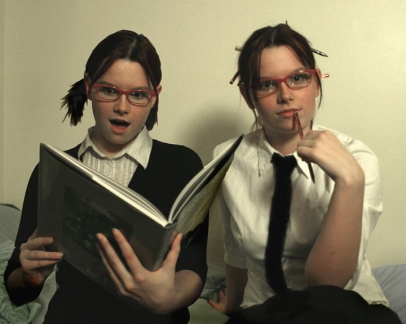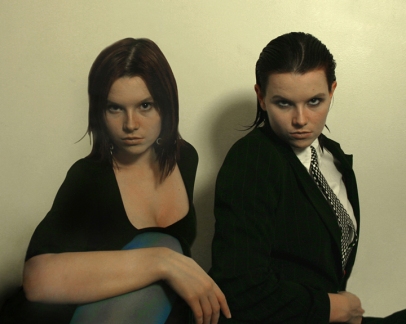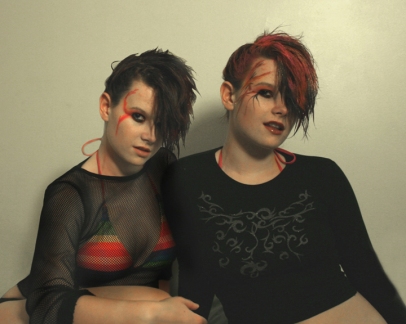Title:
Artist: Nicola Penfold
Type: Inkjet photographic print
Date: 2007
Description: The artist wearing girls’ subcultures styles, duplicated in photoshop. Image completed April 2007. Made in response to Anita Corbin’s photographic series ‘Visible Girls’, Girls Subcultures box held at the London South Bank University, London. A series of 5 images.
Subject: girls, subcultures
Measurements: …x…
Location: London South Bank University Digital Photography Dept
ID Number: PI-RGSB-NP0001-NP006
Licensing: Creative Commons Attribution-Noncommercial 2.0 UK: England & Wales, Nicola Penfold c/o London South Bank University, Digital Photography Course, UK
In 1981, an archive of photographs was created, one containing pictures of girl subcultures. Named ‘Visible Girls’, these photographs by Anita Corbin were, at the time, photographs of girls in subcultures who were overlooked by society. So Anita created an archive of photographs, showing the styles, clothes and tastes of subcultures of the time, including Ska, Mods, Rockers and Reggie. I found many of Anita’s works quite interesting, as they were noticeably so different from modern subcultures. One feature of Anita’s photographs that I liked was that each photograph of the girls was taken in the environment where the subculture would normally be found, such as a club or outside on scooters. In a short introduction that Anita wrote about her subcultures work, she states: “I began to study the informal “uniforms” of young women in August ’80. I’d already looked; in a previous project, at formal uniforms; the “ready-made” stereotypes found in schools, at work and in other institutions. So…I turned my attention to more personal visual details and I became increasingly interested in the effect appearances have on everybody’s lives. The way we often use dress as means of communication/identification and how it can both inform and misinform us” (Corbin, A (1981) Visible Girls: An Introduction).
For my photography project, I closely kept Anita’s work in mind. The colours, position and interaction of the models were a large part of drawing the audience into the picture. The first idea I had for my project was to do a handful of photographs, each of a different subculture. I thought the diversity would make for an interesting set of photographs. But instead of using two models, I decided to use myself to model both girls. I wanted to only include two girls in the photograph to keep with Anita’s original work. To achieve this, I had to set up the camera on a tripod, and using the self-timer, took photographs of myself in a wide-angle frame to make sure I got everything of both models into the shot.
My test shot was the Goth subculture. Once two photographs were chosen, I set about merging them into one frame. I liked the final result, as it looked like a set of twins from the same subculture were sitting for a photograph. I played with the colours in Photoshop to desaturate the red and yellow, bringing the colour cast much closer to some of Anita’s work, especially ones where the background was plain white/cream.
So having chosen my project, I set about deciding how many photograph I would include in the set, and what subcultures they would represent. Finally, I chose six photograph (out of maximum of 7), and the subcultures I chose were: Hippy, Punk, Goth, Geek, Rich Bitch and Mod.
Goth Subculture: The Goth subculture began in the 1980s in the UK, on the gothic rock scene. It began as an offshoot of post-punk, but has lingered much longer than other subcultures from its time, showing diversity as it expands. “Styles of dress within the subculture range from death rock, punk, androgynous, medieval, some Renaissance and Victorian style clothes, or combinations of the above, most often with black attire, makeup and hair” (“Gothic Subculture” http://en.wikipedia.org/wiki/Goth_subculture). For the Goth subculture, clothes and colours are of particular importance.
Punk Subculture: Punk subculture emerged from punk rock in the mid 1970s. Punk subcultures include many styles including clothes, music, film, visual art and ideology, and even a lifestyle. The punk subculture is divided into smaller subcultures, such as streetpunk and hardcore punk.
“These subcultures distinguish themselves through unique expressions of punk culture. Several subcultures have developed out of punk to become distinct in their own right, including Goth and psychobilly. The punk movement has had a tumultuous relationship with popular culture and struggles to resist commercialization and appropriation” (“Punk Subculture” http://en.wikipedia.org/wiki/Punk_subculture).
Hippy Subculture: The Hippy/Hippie subculture began in the 1960s in America. The Hippy movement, although it died down I the mid 1970s, were originally a youth movement who inherited a tradition of cultural dissent from the Bohemians. “Hippies rejected established institutions, criticized middle class values, opposed nuclear weapons (especially in the United Kingdom), opposed the Vietnam War (especially in the U.S.), embraced aspects of non-Judeo-Christian religions, championed sexual liberation, promoted the use of psychedelic drugs to expand one’s consciousness, and created intentional communities” (Hippie Subculture” http://en.wikipedia.org/wiki/Hippies).
Mod Subculture: More a movement than a subculture, Mods (or modernists) began in London in the 1950s, but peaked in the 1960s. Other than fashion and music, scooters were often associated with Mods. “Originally the term mod was used to describe fans of modern jazz music (as opposed to trad, for fans of traditional jazz). Eventually the definition of mod expanded beyond jazz to include other fashion and lifestyle elements, such as continental clothes, scooters and to a lesser degree a taste for pop art, French New Wave films and existentialist philosophy” (“Mod Lifestyle” http://en.wikipedia.org/wiki/Mod_%28lifestyle%29)
Geek Subculture: “The definition of geek has changed considerably over time, and there is no definite meaning. The social and rather derogatory connotations of the word make it particularly difficult to define. The difference between the terms “geek” and “nerd” is widely disputed, as the latter might be identified as someone who is unusually intelligent, and the former as someone who has an eccentric interest towards a certain category or topic” (“Geek” http://en.wikipedia.org/wiki/Geeks).
Daddy’s Girl: Described as “Chick usually young who got lots of dough, usually over 6 figures and flaunts it” (“Rich Bitch” http://www.urbandictionary.com/define.php?term=rich+bitch). Rich Bitch and Daddy’s Girl are similar – rich girls who love to remind everyone they are rich.
From Anita’s photographs, I liked how many of them made the two girls look like sisters and sometimes twins, using clothes especially to link both models to the same subculture.
Other than Anita’s work, another inspiration was the work of Diane Arbus, particularly her photograph “Twins”. It shows two twin girls standing side by side, dressed exactly the same (with the same hair), but one is smiling, and the other is frowning. I liked the effect of this photograph because it really shows the separation between two people who would otherwise look completely identical. Also Cindy Sherman’s work on a similar theme is very interesting, especially the theme of the photograph and the colours used.
Other sources of inspiration for me were found on online gallery network Deviant Art. The feel and colours of many pictures helped me to gain more ideas for each subculture. The pictures below gave me ideas for Goth and punk subcultures. I especially like the lack of colours in the first picture except for some blue (inspiration for Goth) It almost makes the models feel like statues.
For my photographs I wanted to include some popular modern-day subcultures, such as Goth or Daddy’s Girl, but also include some of the subcultures that Anita photographed in 1981, such as Mod and Punk.
Overall, I am fairly happy with my final photographs. I like the idea behind them, but I also like how the idea can easily be traced back to Anita’s work. I tried to use the same stance and position of the models because in Anita’s photographs, the models look very natural, as if she has just snapped them and they didn’t know the camera was there. Even though for each of my photographs, the area in which they were taken is the same, I feel that each subculture made the space their own, using signature colours, poses and expressions to draw the audience in. I’m very glad that I used props in some of the photographs – Hippie with the guitar, Daddy’s Girl with the phone, and Geek with the book – because this definitely adds to the interaction of the photograph. To me, each photograph represents the cultural identity of the subculture very well. My personal favourites are Punk and Goth.
To make my project better, however, I could have taken more time to take the photographs properly. To me some of the prints are slightly flawed (i.e. one is out of focus, and others need minor editing) so that would be one things to improve on.
Even though the colours of the photographs mirror the colours Anita used in some of her photographs, some of my images need better colour management. I feel in a few of them that the colours simply aren’t balanced, and this disrupts the photograph. Next time, I would like to use the studio to do a project like this instead of improvising with home lighting – I feel it would work very well if the studio was used.
But in conclusion, I am happy with my project. I like how each picture separately shows the subculture in a strong light without a need for outside information about it.
Bibliography
• Wikipedia (2007) Subcultures [online] Available at http://en.wikipedia.org/wiki/subcultures (accessed 17th May 2007)
• Wikipedia (2007) Goth Subcultures [online] Available at http://en.wikipedia.org/wiki/Goth_subculture (accessed 17th May 2007)
• Wikipedia (2007) Punk Subcultures [online] Available at http://en.wikipedia.org/wiki/Punk_subculture (accessed 17th May 2007)
• Wikipedia (2007) Hippie Subcultures [online] Available at http://en.wikipedia.org/wiki/Hippie (accessed 17th May 2007)
• Wikipedia (2007) Mod Lifestyle [online] Available at http://en.wikipedia.org/wiki/Mod_%28lifestyle%29 (accessed 17th May 2007)
• Urban Dictionary (2007) Definition: Rich Bitch [online] Available at http://www.urbandictionary.com/define.php?term=rich+bitch (accessed 17th May 2007)
• Google Image Search (2006) Diane Arbus Twins [online] Available at http://images.google.com/images?um=1&tab=wi&ie=UTF-8&rls=GGGL,GGGL:2006-43,GGGL:en&q=Diane+Arbus+twins (accessed 16th May 2007)
• Corbin, A. (2007) Flickr Online Archive of Visible Girls [online] Available at http://www.flickr.com/photos/photographicindex/sets/72157594538834312/ (accessed 8th May 2007)






I was drawn to this series of photographs particularly more than I was to any of the others as they remind me of a kind of fun playful idea I would develop myself for my own work using effective yet simple Photoshop and camera techniques. The meaning of the photos are clearly communicated, with the collection as a whole focusing on the differences within youth sub cultures. By using the same person throughout all photos I feel that more depth has also been added to the work as you can see how easily it is to adapt to any given sub culture through external appearance as well as the mannerisms of the stereotypes being portrayed. I can also clearly see the photographers personal interest regarding stereotype’s ‘uniform’ and personal identification is portrayed through the use of makeup, hair and clothes styling. I also really like the way that the use of two bodies has been utilized in all photographs and we can therefore see the photographers background consideration for the work of Anita Corbin making the work a newer modern intellectual interpretation on a past idea with reference and inspiration. As much as I really like the work for there striking confrontational appeal with clever use of technology the only slight constructive criticism I would have is that photographs such as the one with the ‘Geek’ could have been more naturally shot, as some look a little over acted, especially if overall a more natural stance was desired. Regardless of this I still really enjoy looking at them and for me they stand out more than any other series for their fun dress up aesthetic appeal.
This project has many interesting aspects in my point of view. However the aspect of this project that really catch my attention was that each picture represents one different group of subculture, as contrast of the other projects that are based in just one group of subculture . Other fact that is important to me in these photos is the use of 2 girls representing that subculture which gives more sense of group as you can see in Anita Corbin’s project. The techniques used by the photographer to do this project are other point interesting in this work, as the use of self-portrait to represent all the girls on the photos and all the work in Photoshop to make the photos look like pictures taken of two different girls of the same group. These points make all project modern and creative.
I love your photos. I especially like your goth and hippie photos because of the subtle crossover imagery between the two subcultures. I’ve been experimenting with dark improvised music lately that has turned out sounding like a goth-hippie jam band. A couple of your photos are a dead-on visual representation for what the music brings to mind.